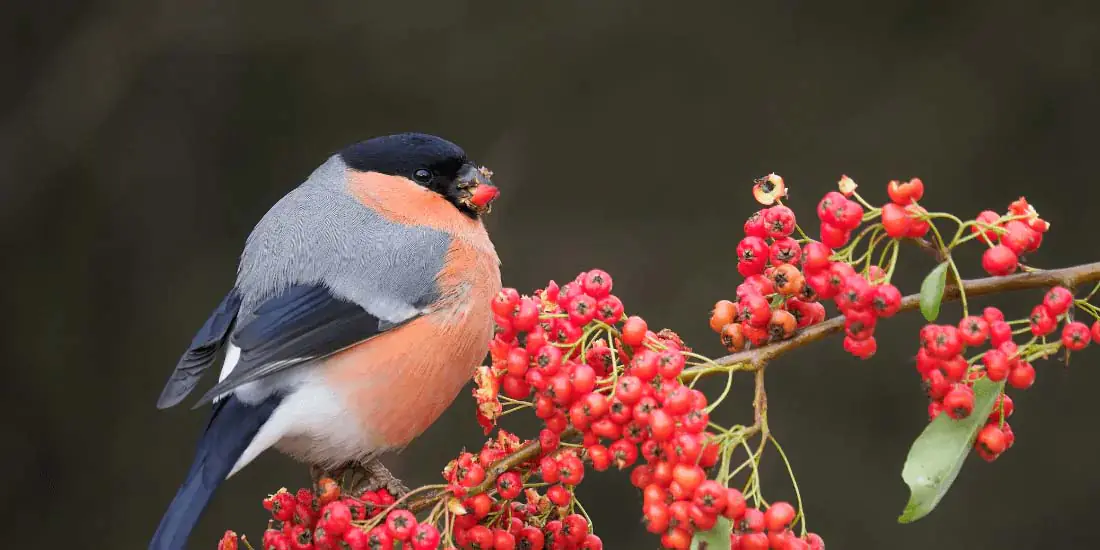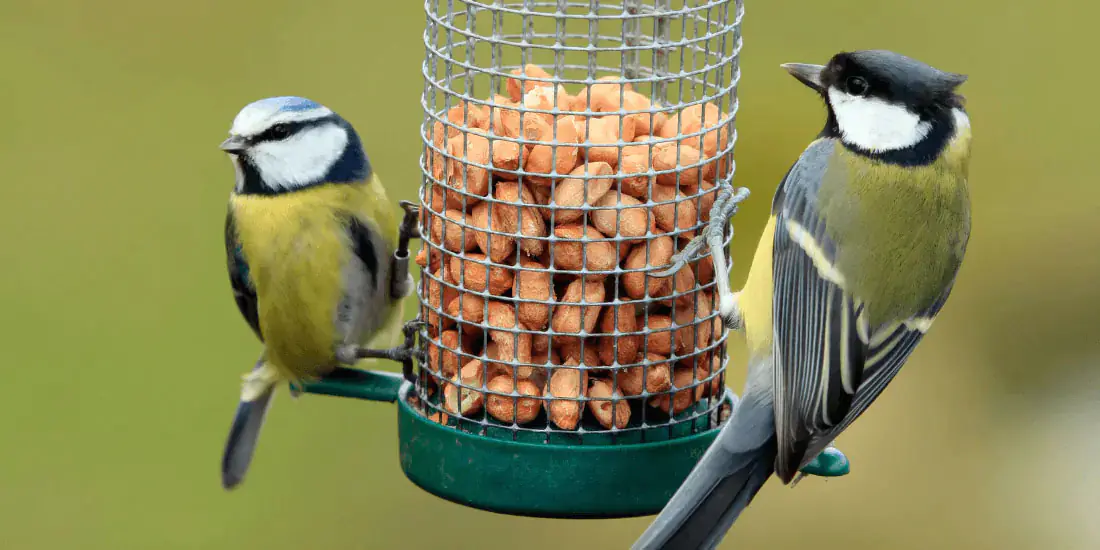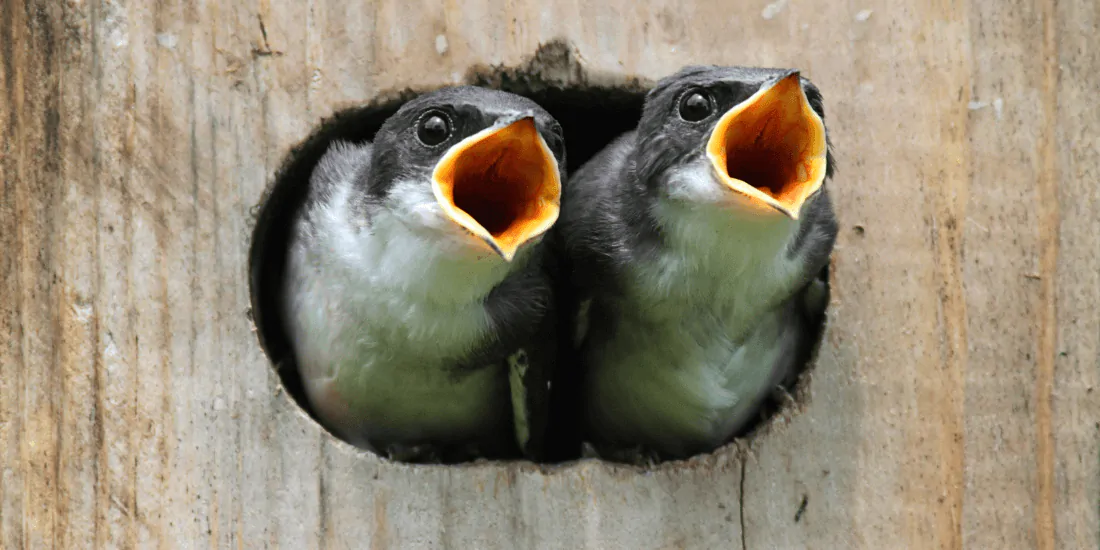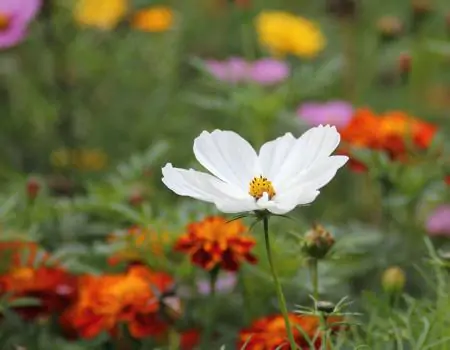We accept:
Wild Birds FAQs
Learn more about sowing, growing and maintaining a wildflower meadow from our Wildflowers Frequently Asked Questions.
Feeding Wild Birds
What do birds eat?
- Wild Birds require high-energy bird food to keep them going all year round.
- Our food mixes offer energy and nutrition suited to a range of wild birds for various seasons throughout the year.
- Birds also love to feast on seed-bearing flowers.
- Perennial flower species offer a long-lasting food source that will return year after year.
- We also advise you to choose a variety of flower types, colours, and heights for a stunning arrangement of flowers to attract a wide range of bird species.
How to choose wild bird food
- We know that choosing wild bird food and bird feeders can be daunting, especially with a large selection of seed mixes and birds' preferences for what foods they like
- Offering wild birds the most nutritious food available will encourage even more bird species to visit your garden and feast at your feeders
- Conveniently, we have a range of high-quality bird food seed mixtures that birds love, and they offer wild birds their much-needed energy and nutrition
How to feed robins
- You may have seen a robin observing you while you dig in your garden, hoping to pinch a few worms as you dig them up
- However, robins also enjoy eating bird food seed mixes like our CHORUS: Songbird Selection Bird Food
- Always set aside some time to ensure fresh water in your garden for robins to drink and bathe in
- Put quality bird food out throughout the year; robins appreciate it in spring and summer for raising their young, giving them extra energy and warmth in winter.
- Be sure never to put milk out for garden birds as it can make them very sick.
- Avoid leaving them out bread – it does fill their bellies, but it’s not beneficial in terms of nutrients or energy.
- Keep your feeders and feeding tables clean, and regularly check the food for signs of mould or rot
- Since robins are natural ground feeders, ground-feeding trays are the ideal option for them
- Like ground feeding trays only elevated off the ground, bird tables give robins an easy place to eat that’s safer from predators
- Robins, like other wild birds, are more likely to spend time in your garden if they feel safe from predators (like cats). You should place bird feeders around 2-metres away from dense vegetation to boost their confidence and ensure their safety
- Robins also like nuts, sunflower hearts, suet, fruit, crushed peanuts, mealworms and even raisins
How to store your bird food
- Knowing how to store your bird food will help to keep your food fresher for longer and safer for the birds
- Below, we share a few quick steps to ensure your bird food is stored correctly:
- Store your bird food in an airtight and watertight container
- Keep your bird food bag in a nice cool space
- Store your bird food it in a dry environment
- Storing birdfood correctly is one of the most important parts of maintaining a good bird feeding routine
What not to feed wild birds
- Food you should not feed to wild birds:
- Fruits with seeds or pits - avoid giving them fruits with seeds or pits
- Milk - Wild birds cannot digest milk; unfortunately, if they do, it will lead to an upset stomach or more serious health problems
- Chocolate - Just like humans, birds find chocolate hard to turn down. However, chocolate is toxic to birds and will give them bad health issues and may even kill them
- Avocado - Avocados may be a superfood for humans, but they are not suitable for birds! This is because they contain a fatty and acidic substance they cannot digest
Bird Feeders
What feeders to choose
- Take these three things into account if you are unsure of what bird feeding option is ideal for you:
- How much space do you have in your garden?
- How much time do you have available to clean and refill feeders?
- What features and styles do you want to add to your garden?
- Hanging bird feeders are a convenient way to feed wild birds because they are easy to clean and require no assembly.
- Bird feeding stations are a good addition if you have some free space in your garden. Likewise, they are great if you already have multiple feeders and are experiencing a large number of daily visitors.
- Bird feeding tables attract the widest variation of seed-eating wild birds. They are surprisingly easy to assemble and can be filled with a wide range of birdseed types.
How to clean your bird feeders
- Clear out your feeders - Before you start cleaning your feeder, we recommend clearing out the old food and disposing of it
- Wash them thoroughly - Now that your feeders are empty, you can start to wash them down. Using hot, soapy water and a cleaning brush, you should give your feeders a thorough and deep scrub, taking care to remove leftover food or droppings.
- Let your feeders dry - Make sure your feeders are fully dry before refilling them; this is just as important as the cleaning. Using a dry cloth, you can pat down your feeder, or you can leave it to air dry.
- When should I clean my feeder? - We recommend cleaning your bird feeder at least once a week. The weather outside will greatly affect when and how often you need to clean your feeder, so it is worth keeping an eye on the forecast.
What bird feeder is best for your garden
- There are some things to consider if you are still unsure which bird feeder is best for your garden:
- How much free space do you have in your garden for bird feeders?
- If you have a smaller garden or yard, then a hanging bird feeder (or two) could be a better option.
- On the other hand, if you have an area of your garden you would like to dedicate to nature, then a bird table or a feeding station could make a great focal point for you to watch come feeding time.
- How much free time do you have for cleaning and refilling your bird feeders?
- Bird feeders, feeding stations and feeding tables do not take much time to clean but it’s advisable to keep an eye on their cleanliness to avoid birds getting sick.
- We recommend you clean your feeders once a fortnight.
- It is important to regularly check your birdseed, suet, and other treats to ensure they have not gone mouldy, rancid, or stale – this is especially important in hot and wet weather.
- Feeders and feeding stations benefit wild birds!
- As you can see, adding bird feeders to your garden is easy and encourages wild birds to visit your garden.
- This is great for you and the family to watch and it benefits your local wildlife all year round.
- For more information available on how to choose the right bird feeder and how to store our high-quality bird food
About Our Bird Products
The Grass People’s Bird Shop
- When The Grass People launched back in 2015 as a grass seed specialist, we knew straightaway that one day we would take things a step further to help our customers create a habitat for local wildlife!
- Fast forward a few years, and we began gradually introducing wild bird food to our catalogue in preparation for the day when we could open our very own bird shop.
- Our drive to achieve this was fuelled by our desire to provide a range of high-quality food for birds, for a wide range of bird breeds and their unique feeding requirements. We also guarantee that our bird food is 100% wheat and filler-free.
- Together with our bird feeding tables, hanging bird feeders or bird feeding stations, bird baths and nesting boxes, you’ll be giving them a haven where they can build a community.
Our wild bird food range
- Garden birds bring a lot of life to your garden and as you probably already know, the U.K. has a fascinating variety of wild birds on offer.
- This means that you will likely get more visitors coming into your garden if you simply leave them out some quality wild bird food.
- We are proud of our wild bird food mixes that we developed to ensure your garden visitors get the most from every meal. Taking this into account, we have tailored our selection of products with birds and nature in mind:
- Four Season Feast Mix: Ideal for feeding wild birds all year round. This mix includes a balanced variety of seeds, nuts, and oats. 100% wheat & filler-free promise.
- Robin Ready Mix: Songbirds like robins, wrens, thrushes, and blackbirds love this seed mix. We have also included kibbled ingredients to suit smaller beaked birds. 100% wheat & filler-free promise.
- Summer Glow High Energy Mix: This everyday feed is rich in nutrients and is ideal for spring and summer. It also helps to keep birds’ energy levels high. 100% wheat & filler-free promise.
- Winter Wellness High Energy Mix: This bird food gives wild birds great energy boosts and is ideal for winter. It features a very nutritious and oily mixture of nuts and seeds. 100% wheat & filler-free promise.
- Our excellent selection of quality seed mixes offers wild birds balanced and nutritious food that benefits their diets.
Our feeders and feeding stations
- Bird feeders and feeding stations are a great way to give wild birds a reliable food source.
- The U.K. has a wide variety of busy bird species that benefit from having extra food on offer to keep their strength up.
- You will likely see more wild birds visiting your garden if you leave them out some quality food hanging in clear view away from predators.
- You may benefit more from a squirrel-resistant seed feeder if you have witnessed squirrels stealing your bird food.
- If you have a larger garden, then a bird feeding station would be a good addition.
- Bird feeding tables are a delightful addition to any garden. Our tables are easy to assemble and you can serve any bird food on them. This means you can offer a selection of food to suit a wide range of birds.
Nesting Boxes
Choosing the right nesting box
- Choosing the right nesting box for the wild birds is important for the birds
- It also gives you more insight into the species you can expect to see visiting your garden.
- For instance, most wild birds use nesting boxes for raising their young, but did you know some bird species will live in a nest box all year round?
- Choosing the best nesting boxes for your garden:
- Nesting boxes come in a range of sizes with different entrance hole diameters to suit different wild bird species.
- For example, an entrance hole of 26-28mm is desirable for tree sparrows, tits, and other smaller birds.
- Whereas nesting boxes with a 32mm entrace hole are perfect for larger native birds like house sparrows and great tits.
- Robins, however, even though they are smaller than sparrows, require an open-ended nesting box with a larger hole so they can see out.
- This information should help you decide one what nesting boxes are ideal for the birds in your area and give you more insight on setting up a liveable environment in your garden for wild birds.
Where should nesting boxes be placed?
- You should place nesting boxes away from direct sunlight and strong winds
- With this in mind, you should place nesting boxes in a sheltered location facing North or East.
- Nesting birds love warmth, but you don’t want the parents or their chicks overheating. Therefore, we advise you should place nesting boxes in an unshaded area away from direct sunlight.
- Ensure birds have a clear path to their nesting boxes
- Birds don’t like any added challenges when returning swiftly after foraging or leaving the nest in a hurry. So make sure nothing is blocking the path to their nest entrance that could make their life harder.
- Consider what height is best for the wild birds in your garden
- The height at which you place a nesting box plays a vital role in whether or not your local birds will roost in your garden.
- It’s worth mentioning that different species prefer to nest at different heights from the ground. Some species even are fussy about how large or small the entrance hole to the nest is.
- Coverage from Trees
- Birds will naturally nest in trees, protecting them from predators while offering them plenty of sticks, twigs and other materials to help with nest building. Trees also help conceal them and provide them with a familiar and comfortable environment.
- Quiet Area of your garden
- We all appreciate birds flying around our gardens while chirping, frolicking and socialising for us to enjoy! Placing nesting boxes around your garden may give a few families a place to call home but be aware when putting them too close together.
- The best location to place nesting boxes in your garden
- Overall, if you think about where your local garden birds would benefit the most when deciding where to place nesting boxes, you will be more likely to attract a wide range of birds that will happily roost and start a family.
When to clean out bird nest boxes
- Most nesting box inhabitants will begin to leave in autumn, from September onwards, but not all birds leave at the same time.
- For this reason, it’s best to clean out bird nest boxes between October and December.
- Observe the nest box before approaching it
- The next step is detaching your birdhouse, but before doing so, make sure that there are no inhabitants by observing it for a week from a distance.
- The best time to do this is in the morning when birds will be swooping around your garden looking for food.
- If you see no birds entering the nesting box, that’s a good sign it is empty.
- Clean the nest box thoroughly
- We recommend wearing gloves for this part!
- Start by carefully removing any bedding from the interior of the nesting box.
- Then use boiling water to clean the interior and kill any parasites. And if there is any stubborn dirt, you can use a wire brush or a sponge scourer to make things easier.
- Please avoid using insecticides, flea powders or commercial cleaners
- After you have cleaned out your bird nest box, you should let it dry out thoroughly before replacing the lid and returning it to where it was mounted before.
- We also have advice on choosing the right nesting box for your garden and where is best to place a nesting box.
Wildlife (Bugs, Bees and Hedgehogs)
Wildflowers that bees love
- Foxglove
- Foxgloves are biennial wildflowers that when sown will reward you with blooms for two whole years.
- Foxgloves in your garden make for a vibrant and versatile addition to your garden, and will also provide a hive of entertainment as bees flock to them.
- Teasel
- Teasel when in flower is great at attracting bees as it becomes a dome of small purple petals, with spikey leaves that are handy to land on and hold on to!
- Whilst this wildflower is great for bees, when it isn’t in bloom it’s also great for birds, in particular Goldfinches who feast on its seeds. So, if you’re looking for a wildflower that attracts bees and much much more, this is a great wildflower to sow!
- Scabious
- Scabious is a recent addition to the RHS Plants for Pollinators list and what an addition it is!
- Sometimes called ‘Butterfly Blue’ scabious is excellent at attracting bees and other pollinators who love its bright petals.
- Clover
- Clover is a great source of pollen for bees and is an easy wildflower to find if you leave your lawn unmown, as it often cultivates naturally in unkempt lawns.
- It’s particularly handy for those bees who are a little bit more tired than the rest as it grows close to the ground, offering them a shorter journey for sanctuary.
- Oxeye Daisy
- Oxeye Daisy’s make for the perfect landing pad for any bee as their bright yellow centre is a welcome sight for tired, hungry bees.
- The British Beekeepers Association suggests that bees will travel up to 5 miles to find food, so a signpost like a brightly centered Oxeye Daisy is a very welcome sight.
- Musk Mallow
- Another new addition to the RHS Plants for Pollinators list, Musk Mallow is a light pink perennial that sits open and welcome for bees to land on.
- It’s easy to access pollen makes it the ideal flower for attracting bees alongside its sweet musky scent that invites them to pop in for more than just a pit stop.
- Bluebell
- Bluebells are typically found in shaded and damp woodland areas, so if a bee happens to find themselves there too, this is one of the first wildflowers they will gravitate too.
- Bees can fit perfectly into their bells and benefit from a few moments of respite to get revitalised for their next trip.
- Knapweed
- Almost resembling some sort of sea anemone, Knapweed is a hot favourite with bees due to its bright colours and open appearance.
- There are different varieties of Knapweed – Greater and Lesser, but to a bee, they’re all exactly the same – delicious!
- Vipers Bugloss
- The electric blue blooms of Vipers Bugloss are irresistible to bees and as its stamen’s stick out, they’re extra easy to get to.
- Offering a pop of colour to your meadow, you can be sure that this wildflower is a tourist attraction for bees far and wide.
- Cowslip
- The only all-yellow wildflower on our list, Cowslip is a ray of sunshine and great source of pollen for bees.
- With its tubular flora it’s another firm fan favourite of bees, who, in particularly hot weather, can enjoy solace, shade and top-notch pollen under its butter-yellow canopy.
- Of course there are lots of other wildflowers that bees like - you can find them all on the RHS Plants for Pollinators list and, if you’re planning to sow some - all of our wildflower mixes contain wildflowers approved on the RHS Plants for Pollinators list.
How to bring more wildlife into your garden
- Have a no mow area
- A wild spot in your garden helps bees, butterflies, and other worldly wildlife have a place to pollinate and patter around.
- Grow wild
- You may have a slightly smaller garden where perhaps letting the grass grow wild or having a meadow isn’t an option – if not, you can still grow bee and butterfly attracting wildflowers in pots, planters or anywhere else you deem fit!
- Leave hedge trimming until later in the year
- Hedges are often species-rich – from insects to birds to a waddling hedgehog on his next adventure, and cutting them down, removing them or lessening their abundance impacts the wildlife that lives within them.
- Feed the birds
- We often forget that birds help the pollination process, so feeding them not only helps sustain their existence but also helps ours in the long run.
- The added advantage of feeding birds? If you have recently sown seed, birds can be fairly curious about it, but if you offer them their very own birdseed buffet in a feeder, they’ll be sure to leave it alone!
- Make a sanctuary
- There has been a general shift in the last decade towards a low-maintenance garden – you know, the type, fencing, paving and artificial grass – and sometimes, artificial plants!
- Unfortunately, this means that the wildlife we were once used to seeing in our gardens has disappeared.
- A great source for instructions for making habitats for wildlife can be found on the RSPB website




